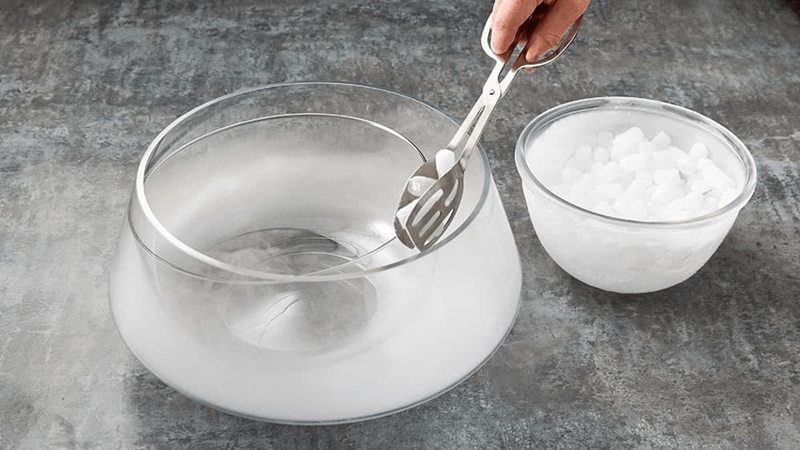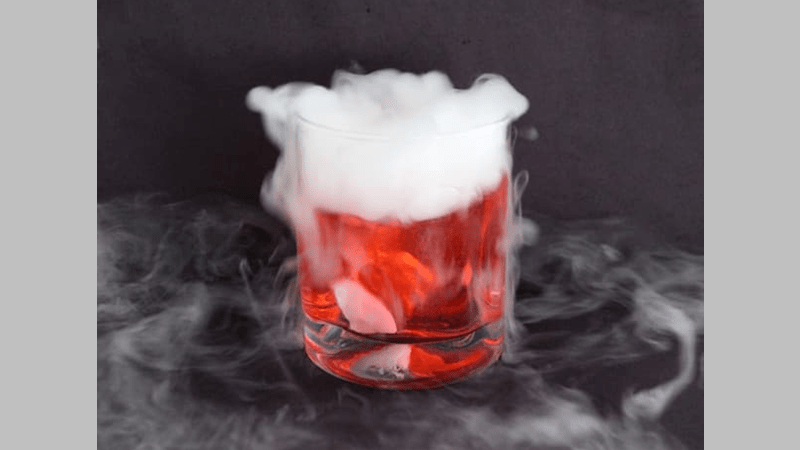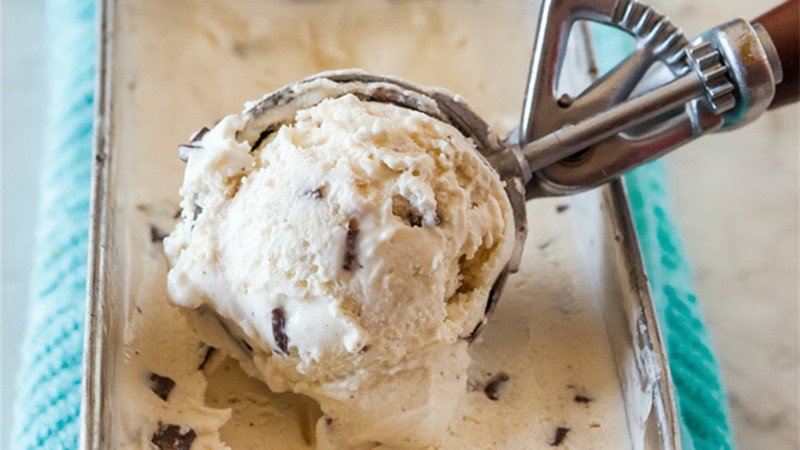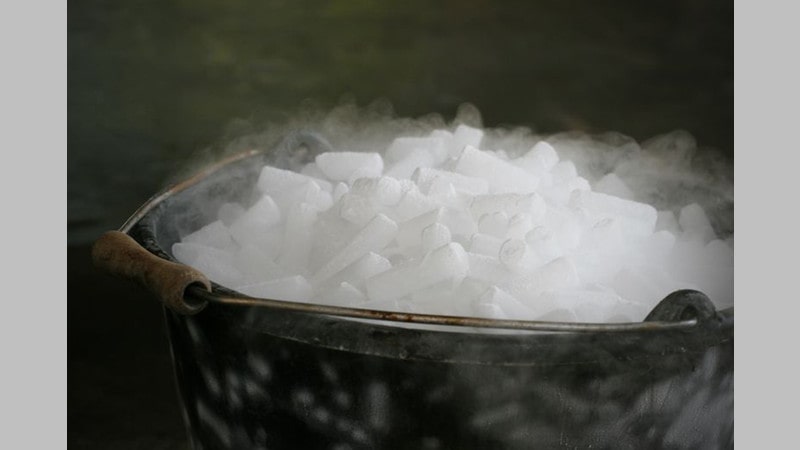Whether they realize it or not, most people have experienced dry ice in one way or another, whether at the local theater or at their neighbor’s latest Halloween party. Many children have even seen or conducted experiments involving this sort of thing. But what is dry ice and how do you use it?
What is Dry Ice?

Image source: Pinterest
Dry ice is the nonflammable, colorless, and odorless solid form of carbon dioxide, frozen at a staggering temperature of -109 degrees Fahrenheit. Unlike most other ice, dry ice turns directly into a gas rather than a liquid. This transformation is the origin of the name dry ice.
How is dry ice made?

Image source: Pinterest
Although it’s easy to make dry ice in a process called “deposition”, there are several steps involved. First, technicians produce and pressurize gases with a high concentration of carbon dioxide.
These gases are then refrigerated until they liquefy to a snow-like consistency. Finally, technicians compress the “snow” into the desired shape and size (often large blocks or small cylinders).
How long does dry ice last?

Image source: Pinterest
As dry ice transforms from a solid directly into a gas, it “sublimates” rather than “melts”, and it sublimes quite quickly. Influenced by storage habits and ice box size, dry ice generally has a short shelf life and should be used within 24 hours. Therefore, it is best to use dry ice the same day it is purchased.
How to use dry ice
Found in many professional settings, including hospitals, laboratories, industrial units, theaters and food centers, dry ice functions primarily as a cooling agent.
However, it can also add memorable special effects to parties or help preserve food for home and hobbies. Preserving, presenting, special effects, and making homemade ice cream are some of the most popular uses for dry ice.

Often used when mechanical cooling is not available, dry ice works well for food preservation. Be sure to place ice away from foods you don’t want to freeze completely, and prevent glass from cracking by isolating any breakable shelves with a pad like newspaper.
Although determined by time of use, size, and weight of the unit or cooler, an average freezer typically requires about 11 pounds of dry ice to keep the contents frozen for 12-24 hours.

Image source: Pinterest
Using dry ice for foggy effects in drinks and food trays can be a fun way to enchant diners and partygoers. Usually these effects are executed by adding smaller portions of dry ice to hot water. However, since you should never ingest it, proceed with caution and look for products that are explicitly made for your intended use.
-
For weddings, holidays and theatrical effect

Image source: Pinterest
From Halloween haunted houses to wedding dance floors, make any event unforgettable with a hazy atmosphere. Unlike the mist created for food trays, these dramatically substantial effects require dry ice and a heated water tank, as well as an optional fog machine.
Adding about 4.5 pounds of dry ice to about 5 gallons of hot water will generate fog for about 10 minutes. Using a fog machine to keep the water temperature from cooling enhances and lengthens the effect.

Although there are several different recipes for dry ice cream, they all follow the same concept: dry ice freezes the other ingredients and carbonates the dish in the process. Essentially, the confectioner slowly mixes crushed dry ice into the ice cream ingredients until it hardens, allowing it to soften before serving.
Why is it safe to consume dry ice, ice cream but not dry ice? As the dry ice mixes with the other ingredients, it sublimates, releasing carbon dioxide, creating carbonated bubbles, and eventually reaching a safe, digestible temperature.
How much dry ice do I need?
The amount of dry ice needed for any project is highly dependent on the details of its intended use. A standard household refrigerator or freezer needs about 11 pounds of dry ice per day to hold its contents. Quantities for chillers vary depending on chiller size, conditions and length of use. Contacting a dry ice supplier is a great way to determine the right amount of dry ice for your needs.
How to store dry ice

Image source: Pinterest
It is essential to keep dry ice in a medium that allows limited infiltration to prevent pressure buildup. Keep it out of direct sunlight and avoid opening the container unnecessarily. Above all, store dry ice in a well-ventilated area, avoiding closed basements and walk-in freezers. Otherwise, the dry ice could sublimate the CO2 to a deadly concentration.
How to get rid of dry ice
Proper disposal of dry ice is of the utmost importance for safe use. Dry ice should never be poured down the sink or flushed down the toilet, as this could cause the pipes to freeze.
Also, never place dry ice in garbage disposals or garbage chutes due to possible pressure and gas buildup. Always let dry ice sublimate naturally in an extremely well-ventilated area.
Precautions and Concerns

Image source: Pinterest
Although fun, useful and quite interesting, dry ice should be handled with care and caution and kept out of the reach of children. Never ingest dry ice as it can cause tissue death and fatal internal damage.
When handling dry ice, wear insulated gloves and, if you chip it, a face shield and goggles to prevent frostbite. Beware that dry ice is heavier than air, collects in lower areas, and high concentrations can lead to hypercapnia. Although carbon dioxide is colorless and odorless, signs and symptoms of overexposure include nausea and vomiting, difficulty breathing, and headache.
Where to buy dry ice
Found in most major retailers and supermarkets, dry ice costs an average of $1 to $3 per pound. You can also buy it online from dry ice vendors in different shapes and sizes for several different specialized uses at varying prices.
The best supplier and the best offer depend on the consumer’s intended use and circumstances. When transporting dry ice, keep the car windows open to allow for better ventilation.
How much does dry ice cost?
The cost of dry ice greatly depends on the quantity, supplier and intended use. Average supermarket prices range between $1 and $3 per pound, while specialty sellers such as Continental Carbonic average around $2 or less per pound, with better prices when bought in bulk.
Reusable ice packs made from dry ice cost around $15 at online retailers such as Amazon. If you are looking for the best deal, calculate exactly how much dry ice you need before buying.
Featured Image Source: Pinterest.com
